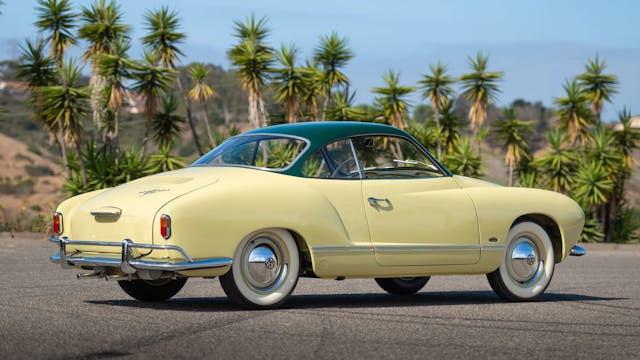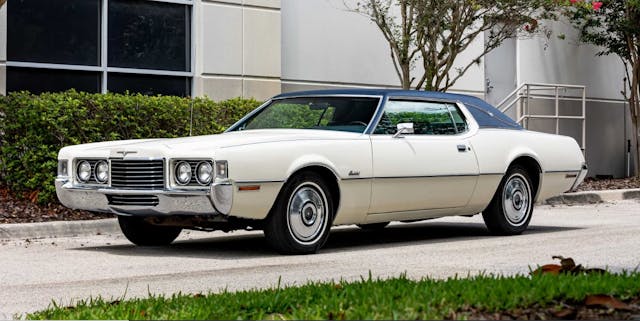5 classics that just got more affordable
The Hagerty Price Guide is updated quarterly, and the methodology takes into account many factors, from auctions to private sales. For a better understanding of how we put it all together, check out this article.
At the close of 2023, you don’t need to be a statistician or religious market-watcher to see that conditions are different compared to a year ago. Our recent update of the Hagerty Price Guide brings that into clear focus. A year ago, we were in the kind of seller’s market not seen since before the Great Recession, with record prices regularly reset and drastic month-over-month appreciation. The similarities with 2008 mostly end there, though. The financial crisis 15 years ago hit the collector car market noticeably, but after a peak of the seller’s market in 2022, the market for collector cars has seen a more gradual and softer slowdown in 2023.
As buyers become more discerning with their purchases and sellers come to grips with their cars no longer bringing a premium for merely existing, the best way to describe what’s happening is air being let out of the bubble. And some sanity coming back to the market is a good thing. Prices are still high for the most part, while some enjoyable cars are trending towards becoming more accessible to the average enthusiast. Speaking of which, here are five of the most significant movers from our latest price guide update that are a lot more accessible (aka affordable) than they were at the beginning of the summer.
1956–75 Volkswagen Karmann Ghia: -16%

Following the success of the Beetle, Volkswagen introduced its new, upscale Type 14 Karmann Ghia for the 1955 model year. The new sporty-looking VW was a collaboration between Volkswagen, who sold the car and provided the underpinnings; Italian firm Carrozzeria Ghia, who designed the bodywork; and German coachbuilder Karmann, who put the car together. Hence the name Volkswagen Karmann Ghia. Over its nearly 20-year production run, the Karmann Ghia saw few major changes and today the biggest determining factor in price is whether or not the roof goes down.
Over the past few years, both the Karmann Ghia and Beetle have experienced astronomical gains in value. These were truly cheap cars in the not-so-distant past, but particularly since 2019 they have stretched well beyond the point of “affordable” or “entry-level” for many enthusiasts on the hunt for cheap air-cooled fun. The 16 percent decrease with this update, led by convertibles, was a notable reversal. After such a rapid climb previously, it’s reasonable to assume that buyers have reached the limit of what they are willing to spend and prices are sliding as a result. Further observation will be needed to call this a trend, however.
1952–56 Woodill Wildfire: -25%

An obscure car even to many car nerds, the Woodill Wildfire is one of those fabulous pieces of forgotten fiberglass to come out of a sports car–crazy 1950s America. After the postwar explosion of independent manufacturers building their own small-batch sports cars, the 1953 Corvette was just one of many fiberglass two-seaters available, and the Vette was actually a bit late to the party. The Wildfire debuted in 1952, and was primarily sold as a kit, although a few were sold as complete cars. Only about 300 Wildfires were ever sold.

For a long time, these have been six-figure cars when in perfect condition. Not bad for an obscure plastic-bodied car, right? Recently, though, one was offered publicly and sold for $31,500, well below its price guide value. Yes, yes, “one sale doesn’t set the market.” We say that all the time, but hear me out.
When a car is so uncommon that only one example pops up every few years, each sale requires close examination. So yes, prices fell, but not nearly as hard as that sale might have suggested they should. What do we do next? Basically, wait for another to come up to give us the opportunity to check the market again, and keep an eye out for any other equally obscure fiberglass cars from the 1950s whose sales might provide a clue.
1972–76 Ford Thunderbird: -15%

Here’s a car we almost never talk about: the sixth-generation Ford Thunderbird. As the 1970s wore on, horsepower numbers in America plunged while the cars themselves got bigger and heavier, and Thunderbirds were no exception. Built on a shared platform with the Continental Mark IV, T-Birds got straight-up huge. With a big ol’ 460-cubic-inch engine making (just barely) over 200 hp, these were not the pinnacle of speed. But speed was never the point of this personal luxury coupe, and more sheetmetal meant more style in the ’70s.
To put the T-Bird’s 15 percent drop into context, these have never been expensive cars, and the median #2 (Excellent) value is just $18,000. 1970s luxury cars have never been the darling of the collector car hobby. With the exception of certain Corvettes and a few other sportier cars, domestics of this era are typically very affordable. The 1972–76 Thunderbird did see sizable growth during 2020 and 2021, but everything has a ceiling, even if it’s a low one. T-Birds in #2 condition peaked just over 22 grand this summer, but both confirmed sales and most listings are lower in recent months, suggesting the transition to a buyer’s market.
A 15 percent drop on a relatively inexpensive car is not a lot dollar-wise, but in this case it’s still worth keeping an eye on. Whether this is a leading indicator that mid-’70s American luxury barges are cooling or just a small blip on the radar, time will tell: We may need a few more updates of the price guide to fully suss out.
1956–59 Lancia Aurelia B24 Convertible: -12%

While Lancia did amazing things in the rally world during the 1970s–90s, it screwed together some fantastic cars during the 1950s and ’60s as well. Case in point: the Aurelia. Both beautiful and innovative, it used a V-6 engine, incorporated a transaxle for improved balance and weight distribution, and even rode on radial tires, all of which was very advanced stuff in the 1950s.
Since Aurelias came in several specs and body styles, their prices range widely, with the special-bodied Spider America selling for over $1M in clean condition. In the latter part of the summer, Coupes and Spiders slid a bit in value, but the Convertible saw the most downward movement. We observed several offerings at Monterey in August, all of which failed to meet expectations. But while the slide of this lesser-known Italian car may not be newsworthy, we observed a softening market for a lot of the high-end Italian sports car market from this era post-Monterey.
1957–61 Jaguar XK150 -13%

Jaguar’s famous XK-series of postwar sports cars ended with the XK150, which debuted in 1957 and was eventually succeeded by the E-Type in 1961. Stylistically, the XK150 was an evolution of the XK120 and XK140 with a slightly more streamlined body, one-piece windshield, and interior improvements like a leather-wrapped dash. Mechanically, the most significant upgrade was the availability of a larger, 3.8-liter engine and disc brakes.
Of the XK150s we track, Drophead Coupes (Convertibles to us Americans) and Roadsters saw the most movement. As with many cars at this price point, much of the auction data we had to work with this past period came out of the Monterey sales. While no concours-grade cars were tracked at the sales, a number of good-condition cars came to market, with all of them selling for lower than expected prices, which suggests that the market for these cars is truly softening.
***
Check out the Hagerty Media homepage so you don’t miss a single story, or better yet, bookmark it. To get our best stories delivered right to your inbox, subscribe to our newsletters.



I agree about having articles geared more toward cars. I like the idea of one focusing on Station Wagons. The old Chrysler New Yorker wagons were stunning. There does not seem to be many of those for sale. Once in awhile one shows up. Also articles that highlight specialty cars from Manufacturers. I am thinking of the limo class cars that were produced by the company. Cadillac, Lincoln, Packard and Chrysler Imperial, although the latter was a joint effort with Ghia. I am sure there were other auto makers that produced limos. Today I think most of them are produced by third party vendors after market. It seems that car manufacturing in the past was a bit more adventurous. They were to an extent willing to try new things. The Chrysler Airflow was a game changer although it almost bankrupted Chrysler. It is amazing how many car makers produced cars with the same body style as the Airflow after Chrysler introduced it.
‘The folks with More money will always criticize those who don’t have Big money to spend —